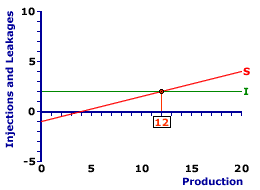
|
|
DOUBLE COINCIDENCE OF WANTS: The requirements of a barter exchange that each trader has want the other wants and wants what the other has. Because everyone doesn't necessarily want everything, the lack of double coincidence of wants is a major obstacle in barter exchanges, especially for complex, modern economies. While double coincidence of wants is also essential for exchanges involving money, it's such an inherent trait of money we don't think twice about it. By its very nature as a generally accepted medium of exchange, everyone WANTS money.
Visit the GLOSS*arama
|
|


|

|
                           MULTIPLIER, INJECTIONS-LEAKAGES MODEL: An analysis of the multiplier principle using the injections-leakages model intersection between the injections line and the leakages line. The injections-leakages model analysis illustrates the Keynesian multiplier as a shift of the injections line (or leakages line) and a subsequent change of the equilibrium level of aggregate production. This analysis illustrates the important role played the marginal propensity to consume (and save), which affects the slope of the leakages line. An alternate but comparable analysis of the multiplier principle is accomplished using the Keynesian cross. The multiplier principle is the notion that relatively small changes in autonomous expenditures or other shocks cause relatively large overall changes in aggregate production and income. The injections-leakages model provides a handy framework for illustrating this multiplier principle. The injections-leakages model is a graphical representation of Keynesian economics based on the intersection of the injections line comprised of investment expenditures, government purchases and exports, and the leakages line comprised of saving, taxes, and imports.The multiplier principle can be illustrated by a vertical shift in the injections line, if triggered by an autonomous expenditure change in investment expenditures, government purchases, or exports. It also can be illustrated by a vertical shift of the leakages line, if triggered by an autonomous change in saving, taxes, or imports. The slopes of the injections and leakages lines, which are based on the assorted induced activities, especially the marginal propensity to save (and consume), then determine the new equilibrium level of aggregate production and the magnitude of the change from the original equilibrium. An Investment ShiftThe essence of the multiplier process can be analyzed using the simple, two-sector injections-leakage, or the savings-investment model. This model is based on the balance between non-consumption expenditures that are injected into the main circular flow and non-consumption uses of income that are leaked out. The simplest injections-leakage model includes the two private sectors -- household and business -- with investment the only injection and saving the only leakage.| An Investment Shift | 
|
The exhibit to the immediate right presents the two-sector injections-leakages model. It can be used to analyze a shock caused by a $1 trillion change in investment expenditures.- To set up this analysis, note that the model contains two lines. The positively sloped line, S, is the saving (leakages) line. The horizontal line, I, is the investment (injections) line.
- The positive slope of the saving line is the marginal propensity to save and indicates that saving is induced by income. This slope is equal to 0.25. The horizontal investment line means that investment is autonomous and unaffected by income and aggregate production.
- The intersection of the two lines identifies equilibrium, which is $12 trillion of aggregate production. This is the initial equilibrium that exists before the autonomous investment expenditure change triggers the multiplier process.
The multiplier process is essentially a disruption of this equilibrium and the adjustment to a new equilibrium. Let's see how this equilibrium is affected by $1 trillion injection of investment expenditures.- This injection causes an upward shift of the investment line. To display this shift, click the [Injection] button. Because this is a change in autonomous investment, the new investment line is also horizontal and parallel to the original investment line.
- The new equilibrium is found by the intersection of the new investment line and the saving line. Click the [Equilibrium] button to highlight equilibrium. This equilibrium results in aggregate production of $16 trillion. The change in aggregate production is $4 trillion.
- The $4 trillion change in aggregate production is four times the initial $1 trillion injection of investment. This indicates that the multiplier is equal to 4.
The results obtained from analysis of the injections-leakages model are the same as those from an analysis of a comparable Keynesian aggregate expenditures model, that is the Keynesian cross. This occurs because the underlying structure is the same for both models. If consumption is the only induced expenditure, then the marginal propensity to consume and marginal propensity to save have the same values. The multiplier is equal to 4 for both. And both analyze the impact of a $1 trillion injection.

Recommended Citation:MULTIPLIER, INJECTIONS-LEAKAGES MODEL, AmosWEB Encyclonomic WEB*pedia, http://www.AmosWEB.com, AmosWEB LLC, 2000-2024. [Accessed: April 28, 2024].
Check Out These Related Terms... | | | | | | | | | |
Or For A Little Background... | | | | | | | | | | | | |
And For Further Study... | | | | |
Search Again?
Back to the WEB*pedia
|



|

|
PURPLE SMARPHIN
[What's This?]
Today, you are likely to spend a great deal of time visiting every yard sale in a 30-mile radius seeking to buy either a remote controlled ceiling fan or a how-to book on home decorating. Be on the lookout for vindictive digital clocks with revenge on their minds.
Your Complete Scope
This isn't me! What am I?
|

|
|
Much of the $15 million used by the United States to finance the Louisiana Purchase from France was borrowed from European banks.
|

|
|
"The roots of education are bitter, but the fruit is sweet." -- Aristotle
|

|
IROR
Internal Rate of Return
|

|
|
Tell us what you think about AmosWEB. Like what you see? Have suggestions for improvements? Let us know. Click the User Feedback link.
User Feedback
|


|


